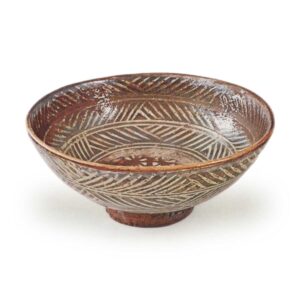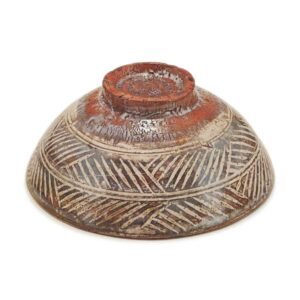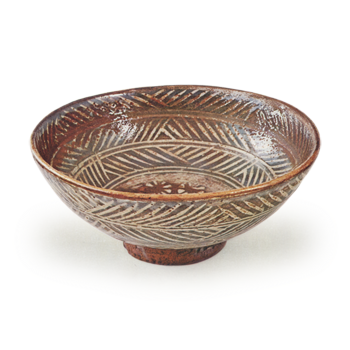

Height: 6.3cm
Diameter: 15.0-15.2cm
Outer diameter of foot ring: 5.4cm
Height of foot ring: 0.9cm
Choshimashima was made in Korea at the request of a tea master during the Momoyama period, and is thought to have been made around the Keicho era. Like Gosomaru, it is thought to be one of the earliest examples of the so-called Gohon-giri style of tea bowl. Among them, the carved Mishima in the collection of the Hatakeyama Museum of Fine Art, which was originally owned by the tea master Matsudaira Fumai, stands out for its softness, and the carving is so clear and precise that this tea bowl is considered to be outstanding. The “Soto Hana” tea bowl, formerly owned by Mitsui Morinosuke, has a floral pattern on the outside, and is considered to be a fine example of the so-called Soto Hana style.
The shape of the bowl, which is shallow and gently flared out from the foot, is refined and elegant, and the bowl is particularly attractive.
On the outside, a double-tiered hinoki-bamboo pattern is clearly carved between two bands, and on the inside, a triple-tiered hinoki-bamboo pattern, slightly narrower than the one on the outside, is revealed. In the center of the inside of the bowl, a nine-petal chrysanthemum pattern is arranged with one in the center and nine around it. All of the carved patterns are clearly visible, with white clay firmly embedded in the glaze. In addition, a thin coat of white paint has been brushed on to the area of the floral pattern and the outside of the arm, and this, against the deep red background, creates a hazy spring-like effect that is also effective in creating an elegant atmosphere.
The white-gray glaze is applied thinly and thickly to the inside of the foot ring, and the bright yellowish-red color of the foot ring blends in beautifully with the color of the clay, creating a truly beautiful scene. The inside of the foot ring has been scraped to create a crinkled texture, and the white-grey glaze has been applied to this area as well, but in places where the glaze is thick, the kaaragi pattern can be seen.
The foot ring has been slightly thinned out, and the clay used is a red clay with a high iron content. There are eight marks where the tatami mat was attached, and there are also nine marks of various sizes on the flower pattern on the inside.
The overall finish is a little stiff, but the glaze has a glossy sheen, and it is a tea bowl that is clearly rich in luster.
All of the carved Mishima ware have a cypress pattern, but this tea bowl is called “Higaki” because the cypress pattern is particularly outstanding and makes a strong impression. Also, the tea bowl that most closely resembles this one is the one with the name “Zansetsu” that is listed in the Taisho Meiki Kan as being in the collection of Masayoshi Kato.
The inner box is decorated with a combination of dark and light colors, and the three characters “hinoki-kaki” (cypress carving) in gold powder on the lid are said to have been written by Toramaru Mitsuhiro, who was known as one of the three great calligraphers of the Kan’ei era. handwriting. The origin of the bowl in the olden days is unclear, and the only information given in the Taisho Meiki Kan (A Guide to Famous Tea Bowl from the Taisho Period) is that it was formerly owned by Kato Masayoshi, and then passed to Itami Shintaro, who passed it on to the current owner (at the time, it was owned by Dan Takuma). However, such a famous bowl must have had a proper history of ownership.



